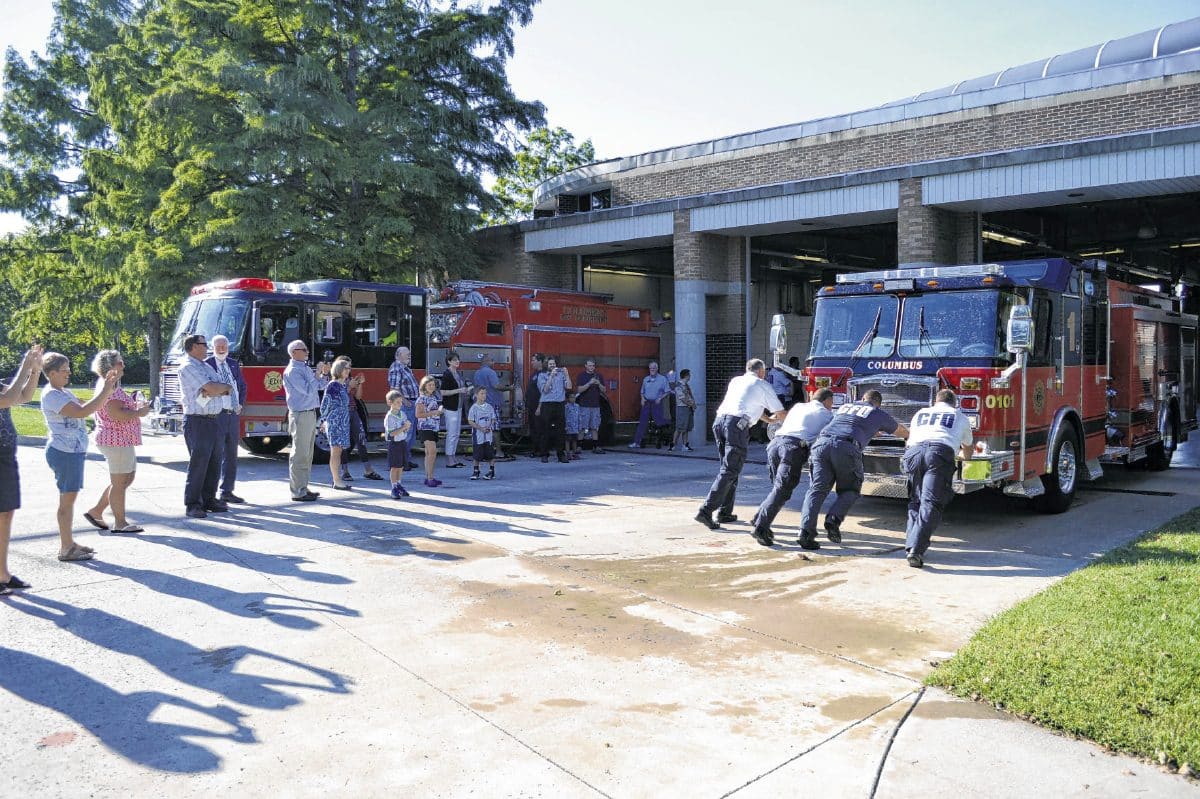Ashlyn Huffman described it as extremely painful for about 10 seconds and said she had trouble catching her breath.
Kat Norman recalls being in shock and then feeling kind of numb for a couple of days.
Kelsey Patberg remembers about 15 seconds of pain, then rolling over and ripping out chunks of grass, it hurt so bad.
Ask anyone who’s had an anterior cruciate ligament knee injury, better known as an ACL, and they will tell you it’s not the most pleasant experience. Then, throw in the grueling rehab process and the emotion of having to miss games and practices, and the injury can take a significant toll on any athlete.
[sc:text-divider text-divider-title=”Story continues below gallery” ]
“I was still crying after the pain was gone just because I was scared,” Patberg said. “I know that a pop comes with an ACL injury, so I knew that’s what it was. But I was scared because I didn’t want it to be that.”
Patberg, like Huffman and Norman, are Columbus North girls basketball players. All tore their ACLs within three months of each other last summer, and all have missed at least part of this season.
Because Patberg’s injury did not happen until September — during a soccer practice — and because she’s a junior, doctors advised her not to rush the knee to try to get back this basketball season. She does not plan to play soccer this fall and is focused on getting back for next basketball season.
Huffman, a senior, and Norman, a junior, meanwhile, are back in their familiar roles for a North team that will host its sectional beginning Tuesday and concluding on Saturday. Huffman, who tore the ACL in her left knee July 8 while playing with the Skye Diggs Elite AAU team, missed the Bull Dogs’ first five games before returning to her starting point guard spot.
Previously, Huffman had torn the ACL in her right knee while at Franklin Central before transferring to North. Then last February, she tore the meniscus in her right knee during the regional.
“But even now that I’m back playing, you get stuck in stuff, and some habits form that aren’t always the best and it gets frustrating sometimes, like ‘Will I ever be back to where I was?’” Huffman said. “There’s a lot of that that goes through your mind. But I know from my previous ACL, I made it back to where I was before that, so that helped a lot with my confidence, knowing that I can get there again.”
Norman tore her ACL on July 23 while playing for the Indiana Faith AAU team. The junior forward was along the baseline, and a teammate threw a low pass from the top of the key. Norman tried to catch it and landed awkward, and the knee popped.
Since making a brief appearance in the North Invitational just before Christmas, Norman has seen increased playing time coming off the bench.
“I was really upset (with the injury) because I had been working hard all summer, trying to get better and getting in shape,” Norman said. “Then, when I got hurt, it was just kind of a bummer to know that hard work might not have paid off, or I might not be able to continue for awhile and have to redo everything.”
Anatomy of the knee
The ACL is in the center of the knee. Its main function is to stop the tibia from sliding forward when the knee stops. It is not used in straight-line running.“I always liken the ACL to a seat belt,” said Dr. Cary Guse, a surgeon with Southern Indiana Orthopedics. “You have it on at all times in the car, but it’s not always used. There are many times when an ACL is not being used at all.”
When injured, the ACL can tear off the top side of the bone (the femur) or the bottom bone (the tibia) or can just tear in half.
If the ACL is not functioning and is torn, it will not recover. The knee will shift and give out.
Guse said some middle-aged and older people can get by without an ACL since they’re not running, jumping or shifting as much as young athletes. He said it would be atypical to return to high-level athletics with a torn ACL.
Girls at higher risk
Guse said there’s no question that females have risk factors that can’t easily be changed. He said girls are three to seven times more likely to tear an ACL than boys.Girls have a wider pelvis than boys, which causes a higher knee angle that puts more force on the ACL. Guse said females also are quad-dominant, which also puts more stress on the ACL.
Dr. Ilya Schwartzman, who doubles as the East girls soccer coach, agreed that these factors tend to put girls at greater risk. He has had players of all shapes and sizes tear their ACLs.
“It doesn’t seem to matter the build,” he said. “Soccer, because there’s so much change of direction and stop-and-go-action and pressure on the knee, it happens. It’s a risk that every athlete takes when they play sports.”
Guse said single-sport athletes also have a higher risk of injury than multi-sport athletes since they are using the same muscles over and over again.
Columbus North girls basketball coach Pat McKee, who lost two of his players during summer basketball, thinks specialization might be a factor. He said the injuries tend to happen more on the summer AAU circuit where teams are playing game after game after game, putting more stress on players’ knee ligaments.
“Is there adequate rest time? Is there adequate re-warmup time when you’re in the second or third game of the day? I’m not saying there isn’t, but I’m not sure there’s as much monitoring of that in a summer environment as there is in a winter school environment,” McKee said.
Afflicting the stars
Possibly the two most accomplished female athletes ever to come out of Columbus haven’t been able to avoid an ACL tear.
Soccer player Morgan Proffitt was out of action about four months, while basketball player Ali Patberg missed an entire year.
Proffitt tore her ACL playing club soccer the summer before her senior year at North, calling it the worst pain of her life for about 10 seconds. She returned on senior night and played in the sectional, then enjoyed a stellar four-year career at Marquette University that was capped by selection as Big East Defensive Player of the Year.
Earlier this month, Proffitt was selected in the second round of the Women’s Professional Soccer League by the Chicago Red Stars. She said missing most of her senior year in high school wasn’t easy.
“I hadn’t been majorly injured up until that point. So to be out four to six months, that’s pretty tough,” Proffitt said. “I had to do my rehab while they were out competing. It’s definitely tough mentally and physically.”
Ali Patberg, who is Kelsey’s cousin, tore her ACL on Nov. 2, 2015, during preseason practice at Notre Dame. That happened just six months after leading the Bull Dogs to the Class 4A state title and earning Indiana Miss Basketball and McDonald’s All-American honors.
While working out with the team last summer, Ali Patberg began experiencing pain. She had a second surgery Aug. 3 to remove bone spurs from her surgically repaired right knee.
Finally, Patberg returned to the court when Notre Dame practice began in October.
“It’s a very long process,” she said. “It gets better every day. I didn’t play basketball for about a year, so it’s rough.”
Ali Patberg said she’s not back to 100 percent yet, but she’s close, noting that she has started to be more aggressive offensively and is moving well laterally on defense.
Since coming back from a case of pneumonia that sidelined her for 2½ weeks and allowed the knee time to rest, Patberg has been playing without a knee brace that she wore at the beginning of the season.
“The biggest part to the whole thing is mentally thinking you’re OK,” Patberg said. “I don’t even realize in a game that I tore my ACL. That’s where you mentally get over the hump.”
Prevention and rehab
Several years ago, North teamed with Columbus Regional Hospital to do an ACL prevention program for volleyball and basketball players. Players went through exercises designed to prevent ACL injuries every day before or after practice for six weeks.Guse said the biggest preventative measure is quad strength and making sure athletes have two equally strong legs — not one good leg and one bad leg. If they’re landing in a knock-kneed position, there is much more force.
The prevention programs are designed to make the quads stronger and make sure the athlete is landing balanced — not on one leg more than the other — and with the knees straight up and down.
Guse said the thinking was that if they do exercises such as hamstring curls for 5 or 10 minutes a day, they might minimize that risk. To his knowledge, nobody in that pilot prevention program at North tore their ACL that year.
Meanwhile, Schwartzman began putting his girls soccer teams through plyometric and strengthening programs about 10 years ago. The plan worked — at the beginning.
“After initiating it, we had a few years of no injuries, and we thought we were onto something,” Schwartzman said. “But then we had it again. Unfortunately, they still keep occurring, despite the best intentions to prevent it.”
People who tear their ACLs are at risk of tearing the same ACL or the one in the opposite knee. Guse cited a study by the Moon Group, a collaboration of ACL experts across the country, that showed a 7 percent to 10 percent recurrent rate nationally.
Following surgery, Guse puts patients through six stages or rehab — swelling control, range of motion, strength, balance, sport-specific movements and explosion. A lot of the rehabilitation centers around getting rid of the recurrent risk factors that they can.
The long road back
Like her first ACL surgery 2½ years ago, Huffman’s absence from the court lasted about four months following her latest surgery.“I’m very, very thankful for that because you have to have a lot of things go right for a four-month recovery, and I have a mom who’s a physical therapist, which was extremely helpful,” Huffman said. “The first month is definitely the hardest in therapy. If you can get through that, you can get through almost anything after that.”
Norman was out for 15 weeks following her surgery. She said she could gradually do more and more exercised with every rehab appointment she attended.
Kelsey Patberg, who is 4½ months removed from her injury, has been cleared to run and jump but not practice.
Huffman, who last week committed to play at Cedarville (Ohio) University, admitted she sometimes thinks about her surgically-repaired knees when she’s out on the court. She hopes to get back to being as aggressive as she was before the latest injury.
“Sometimes, I’ll be sitting in a timeout, and be like, ‘What if this is the next play that is another knee injury?’” Huffman said. “On the court, I’ll tweak it sometimes and get a little nervous.”
Norman, meanwhile, said she usually doesn’t think about her injury.
“I just go out there and play, and it usually doesn’t bother me,” she said. “I just try to play as hard as I can and do whatever I can to help my teammates and just play hard and work on my conditioning and get better.”
Both Norman and Huffman said they’re glad to be done with rehab and are happy to be back on the court.
“There’s a new love for the game when you’re out for that long,” Huffman said. “It’s frustrating, but when you get back, even when things aren’t going your way, it’s good to be able to take a step back and say, ‘At least I’m playing.’”
[sc:pullout-title pullout-title=”Incidence rates of high school sports injuries” ][sc:pullout-text-begin]
A Journal of Athletic Training High School Sports-Related Injury Surveillance Study from the 2007-08 through 2011-12 school years lists girls basketball as having the highest rate of ACL injuries as a proportion to all injuries in that sport. The breakdown:
Girls basketball: 6 percent
Girls soccer: 5 percent
Softball: 3 percent
Football: 3 percent
Volleyball: 3 percent
Boys soccer: 3 percent
Boys basketball: 2 percent
Baseball: 1 percent
Wrestling: 1 percent
Overall: 3 percent
[sc:pullout-text-end]





